Advanced Financial Accounting Report: AASB 16 and Company Analysis
VerifiedAdded on 2022/10/17
|9
|3014
|449
Report
AI Summary
This report provides a comprehensive analysis of advanced financial accounting, focusing on the application of accounting concepts, the impact of the new accounting standard AASB 16 on lease accounting, and key disclosures made by a selected company, Woodside Petroleum. The report begins by outlining the accounting concepts used by the company, referencing the Corporations Act 2001, AASB, and IFRS. It then delves into the details of AASB 16, explaining the changes in lease accounting, particularly the requirement to report operating leases on the balance sheet. The analysis includes the implications of the new standard on the lessee, the recording of lease costs, and the impact on taxation and financial disclosures. The report concludes with a summary of the key disclosures made by the company regarding its accounting for leases, including transitional provisions and the effects of transitioning from AASB 117. The report incorporates examples and discussions relevant to Woodside Petroleum's financial reporting practices.
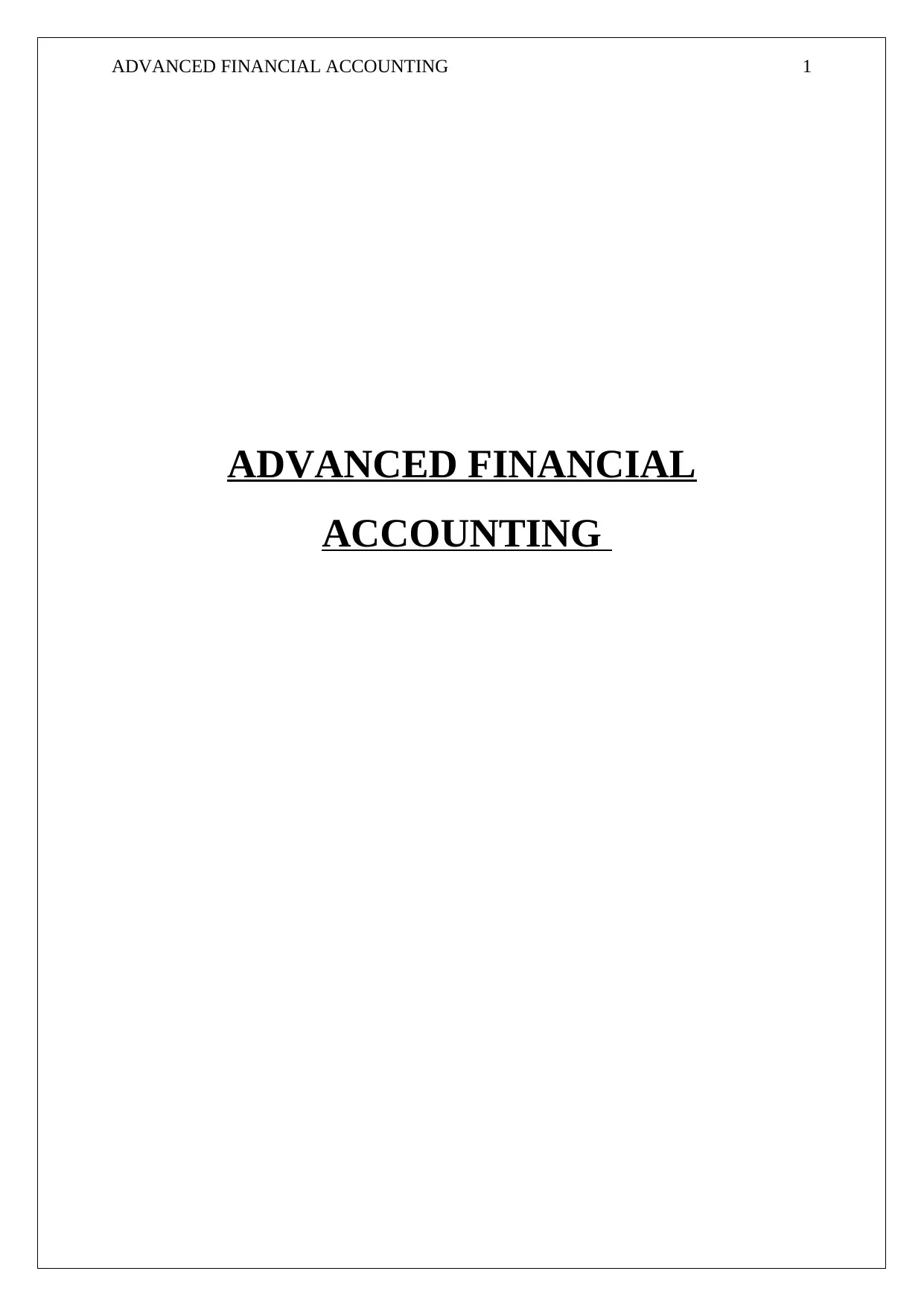
ADVANCED FINANCIAL ACCOUNTING 1
ADVANCED FINANCIAL
ACCOUNTING
ADVANCED FINANCIAL
ACCOUNTING
Paraphrase This Document
Need a fresh take? Get an instant paraphrase of this document with our AI Paraphraser
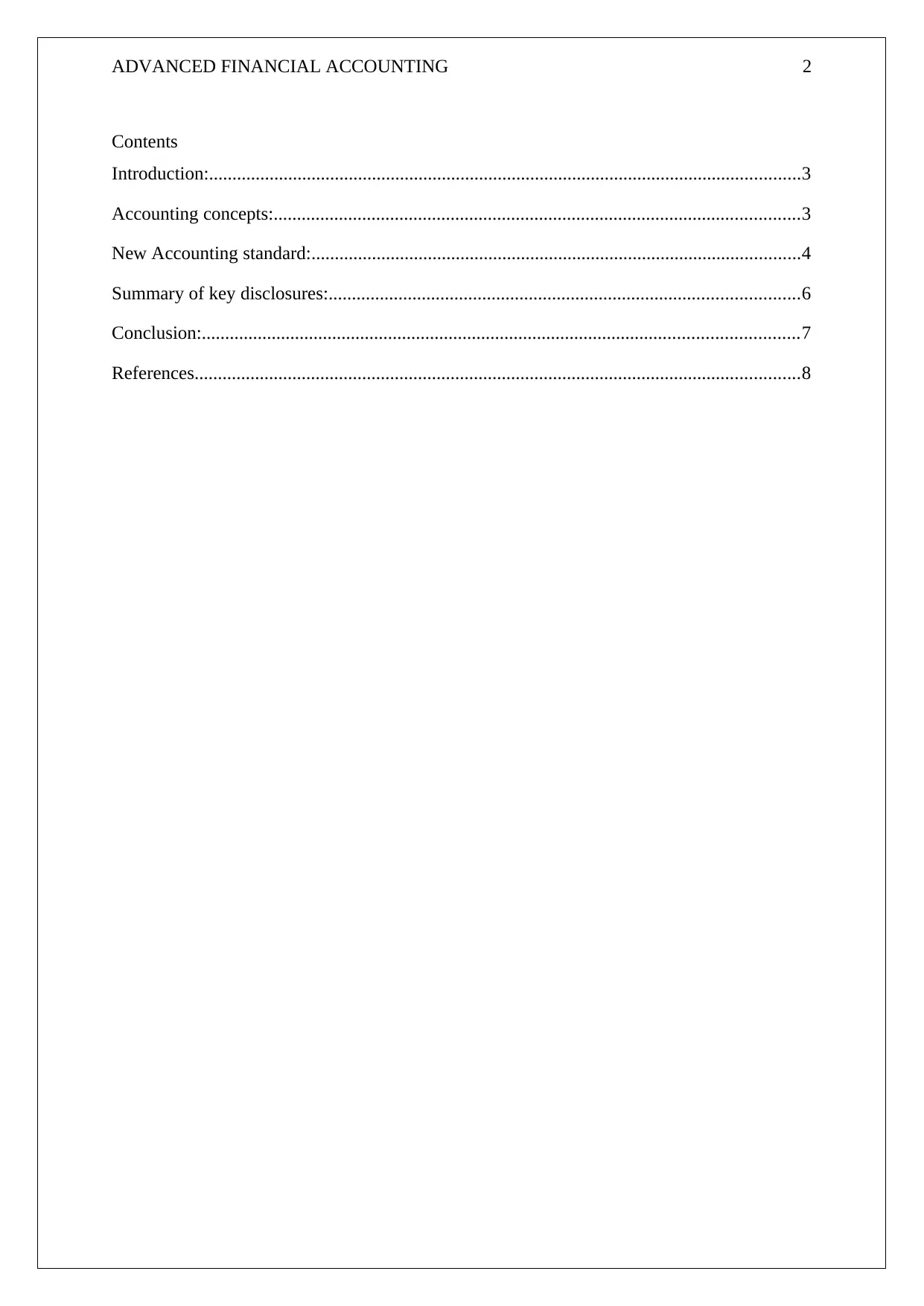
ADVANCED FINANCIAL ACCOUNTING 2
Contents
Introduction:...............................................................................................................................3
Accounting concepts:.................................................................................................................3
New Accounting standard:.........................................................................................................4
Summary of key disclosures:.....................................................................................................6
Conclusion:................................................................................................................................7
References..................................................................................................................................8
Contents
Introduction:...............................................................................................................................3
Accounting concepts:.................................................................................................................3
New Accounting standard:.........................................................................................................4
Summary of key disclosures:.....................................................................................................6
Conclusion:................................................................................................................................7
References..................................................................................................................................8
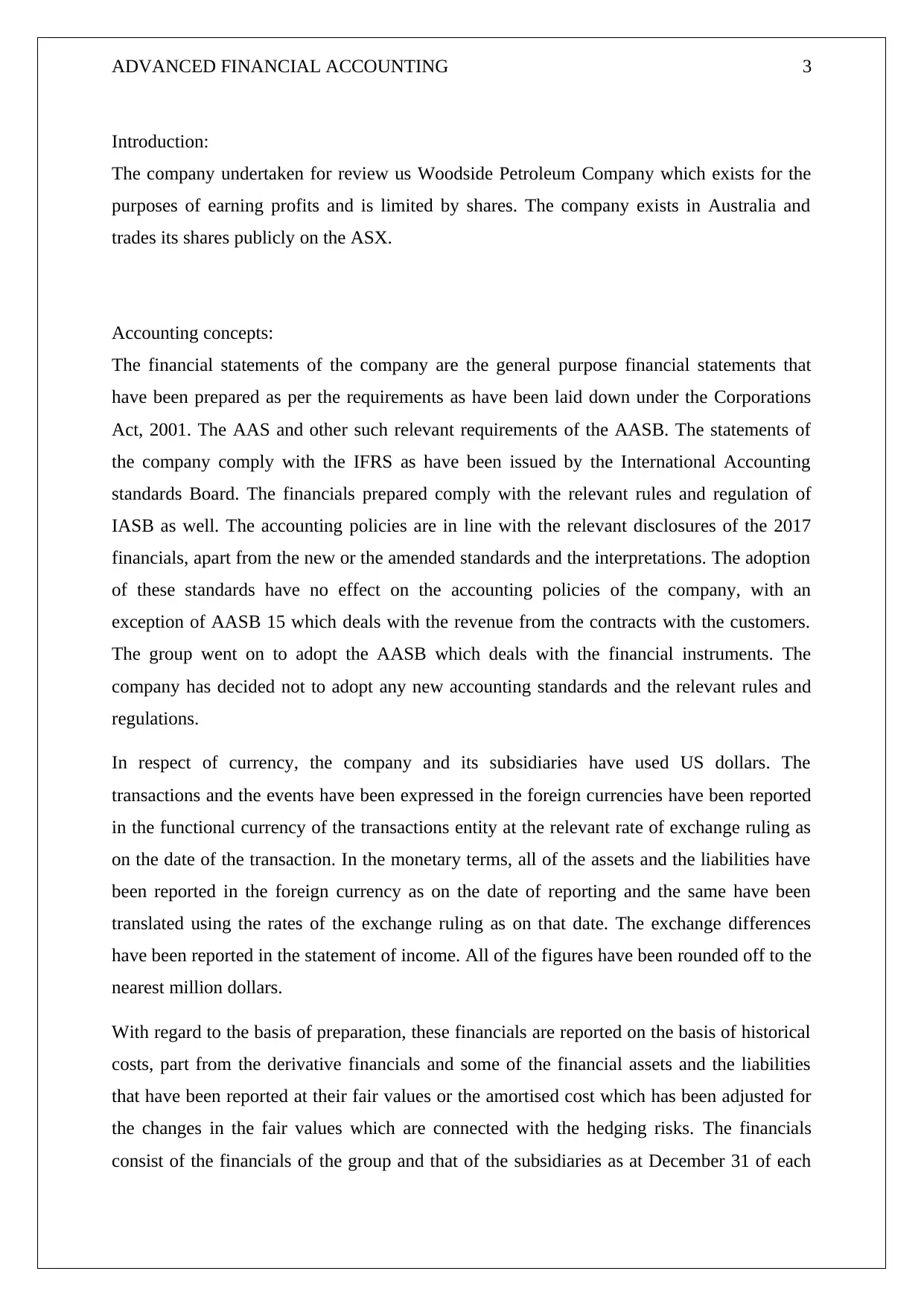
ADVANCED FINANCIAL ACCOUNTING 3
Introduction:
The company undertaken for review us Woodside Petroleum Company which exists for the
purposes of earning profits and is limited by shares. The company exists in Australia and
trades its shares publicly on the ASX.
Accounting concepts:
The financial statements of the company are the general purpose financial statements that
have been prepared as per the requirements as have been laid down under the Corporations
Act, 2001. The AAS and other such relevant requirements of the AASB. The statements of
the company comply with the IFRS as have been issued by the International Accounting
standards Board. The financials prepared comply with the relevant rules and regulation of
IASB as well. The accounting policies are in line with the relevant disclosures of the 2017
financials, apart from the new or the amended standards and the interpretations. The adoption
of these standards have no effect on the accounting policies of the company, with an
exception of AASB 15 which deals with the revenue from the contracts with the customers.
The group went on to adopt the AASB which deals with the financial instruments. The
company has decided not to adopt any new accounting standards and the relevant rules and
regulations.
In respect of currency, the company and its subsidiaries have used US dollars. The
transactions and the events have been expressed in the foreign currencies have been reported
in the functional currency of the transactions entity at the relevant rate of exchange ruling as
on the date of the transaction. In the monetary terms, all of the assets and the liabilities have
been reported in the foreign currency as on the date of reporting and the same have been
translated using the rates of the exchange ruling as on that date. The exchange differences
have been reported in the statement of income. All of the figures have been rounded off to the
nearest million dollars.
With regard to the basis of preparation, these financials are reported on the basis of historical
costs, part from the derivative financials and some of the financial assets and the liabilities
that have been reported at their fair values or the amortised cost which has been adjusted for
the changes in the fair values which are connected with the hedging risks. The financials
consist of the financials of the group and that of the subsidiaries as at December 31 of each
Introduction:
The company undertaken for review us Woodside Petroleum Company which exists for the
purposes of earning profits and is limited by shares. The company exists in Australia and
trades its shares publicly on the ASX.
Accounting concepts:
The financial statements of the company are the general purpose financial statements that
have been prepared as per the requirements as have been laid down under the Corporations
Act, 2001. The AAS and other such relevant requirements of the AASB. The statements of
the company comply with the IFRS as have been issued by the International Accounting
standards Board. The financials prepared comply with the relevant rules and regulation of
IASB as well. The accounting policies are in line with the relevant disclosures of the 2017
financials, apart from the new or the amended standards and the interpretations. The adoption
of these standards have no effect on the accounting policies of the company, with an
exception of AASB 15 which deals with the revenue from the contracts with the customers.
The group went on to adopt the AASB which deals with the financial instruments. The
company has decided not to adopt any new accounting standards and the relevant rules and
regulations.
In respect of currency, the company and its subsidiaries have used US dollars. The
transactions and the events have been expressed in the foreign currencies have been reported
in the functional currency of the transactions entity at the relevant rate of exchange ruling as
on the date of the transaction. In the monetary terms, all of the assets and the liabilities have
been reported in the foreign currency as on the date of reporting and the same have been
translated using the rates of the exchange ruling as on that date. The exchange differences
have been reported in the statement of income. All of the figures have been rounded off to the
nearest million dollars.
With regard to the basis of preparation, these financials are reported on the basis of historical
costs, part from the derivative financials and some of the financial assets and the liabilities
that have been reported at their fair values or the amortised cost which has been adjusted for
the changes in the fair values which are connected with the hedging risks. The financials
consist of the financials of the group and that of the subsidiaries as at December 31 of each
⊘ This is a preview!⊘
Do you want full access?
Subscribe today to unlock all pages.

Trusted by 1+ million students worldwide
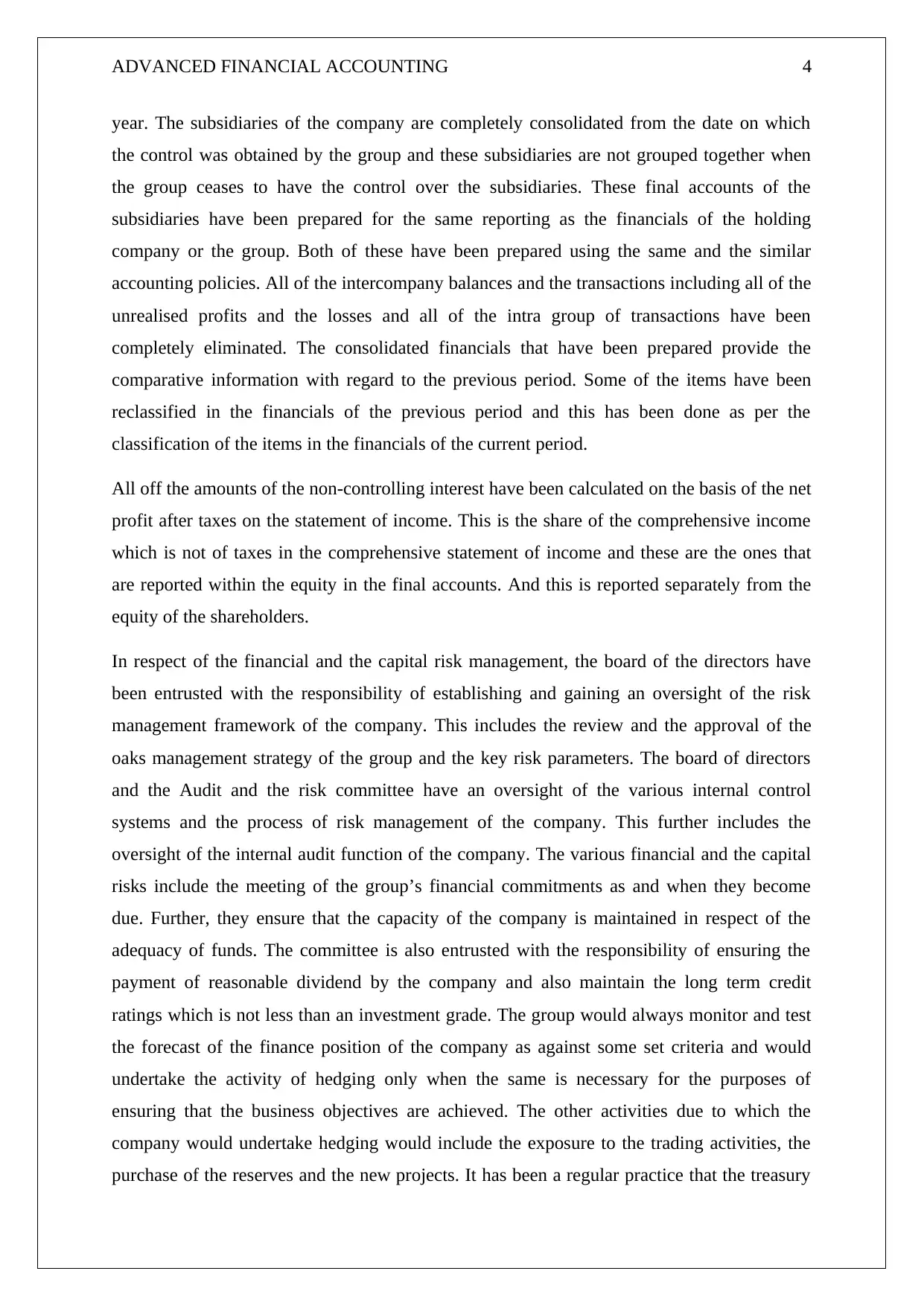
ADVANCED FINANCIAL ACCOUNTING 4
year. The subsidiaries of the company are completely consolidated from the date on which
the control was obtained by the group and these subsidiaries are not grouped together when
the group ceases to have the control over the subsidiaries. These final accounts of the
subsidiaries have been prepared for the same reporting as the financials of the holding
company or the group. Both of these have been prepared using the same and the similar
accounting policies. All of the intercompany balances and the transactions including all of the
unrealised profits and the losses and all of the intra group of transactions have been
completely eliminated. The consolidated financials that have been prepared provide the
comparative information with regard to the previous period. Some of the items have been
reclassified in the financials of the previous period and this has been done as per the
classification of the items in the financials of the current period.
All off the amounts of the non-controlling interest have been calculated on the basis of the net
profit after taxes on the statement of income. This is the share of the comprehensive income
which is not of taxes in the comprehensive statement of income and these are the ones that
are reported within the equity in the final accounts. And this is reported separately from the
equity of the shareholders.
In respect of the financial and the capital risk management, the board of the directors have
been entrusted with the responsibility of establishing and gaining an oversight of the risk
management framework of the company. This includes the review and the approval of the
oaks management strategy of the group and the key risk parameters. The board of directors
and the Audit and the risk committee have an oversight of the various internal control
systems and the process of risk management of the company. This further includes the
oversight of the internal audit function of the company. The various financial and the capital
risks include the meeting of the group’s financial commitments as and when they become
due. Further, they ensure that the capacity of the company is maintained in respect of the
adequacy of funds. The committee is also entrusted with the responsibility of ensuring the
payment of reasonable dividend by the company and also maintain the long term credit
ratings which is not less than an investment grade. The group would always monitor and test
the forecast of the finance position of the company as against some set criteria and would
undertake the activity of hedging only when the same is necessary for the purposes of
ensuring that the business objectives are achieved. The other activities due to which the
company would undertake hedging would include the exposure to the trading activities, the
purchase of the reserves and the new projects. It has been a regular practice that the treasury
year. The subsidiaries of the company are completely consolidated from the date on which
the control was obtained by the group and these subsidiaries are not grouped together when
the group ceases to have the control over the subsidiaries. These final accounts of the
subsidiaries have been prepared for the same reporting as the financials of the holding
company or the group. Both of these have been prepared using the same and the similar
accounting policies. All of the intercompany balances and the transactions including all of the
unrealised profits and the losses and all of the intra group of transactions have been
completely eliminated. The consolidated financials that have been prepared provide the
comparative information with regard to the previous period. Some of the items have been
reclassified in the financials of the previous period and this has been done as per the
classification of the items in the financials of the current period.
All off the amounts of the non-controlling interest have been calculated on the basis of the net
profit after taxes on the statement of income. This is the share of the comprehensive income
which is not of taxes in the comprehensive statement of income and these are the ones that
are reported within the equity in the final accounts. And this is reported separately from the
equity of the shareholders.
In respect of the financial and the capital risk management, the board of the directors have
been entrusted with the responsibility of establishing and gaining an oversight of the risk
management framework of the company. This includes the review and the approval of the
oaks management strategy of the group and the key risk parameters. The board of directors
and the Audit and the risk committee have an oversight of the various internal control
systems and the process of risk management of the company. This further includes the
oversight of the internal audit function of the company. The various financial and the capital
risks include the meeting of the group’s financial commitments as and when they become
due. Further, they ensure that the capacity of the company is maintained in respect of the
adequacy of funds. The committee is also entrusted with the responsibility of ensuring the
payment of reasonable dividend by the company and also maintain the long term credit
ratings which is not less than an investment grade. The group would always monitor and test
the forecast of the finance position of the company as against some set criteria and would
undertake the activity of hedging only when the same is necessary for the purposes of
ensuring that the business objectives are achieved. The other activities due to which the
company would undertake hedging would include the exposure to the trading activities, the
purchase of the reserves and the new projects. It has been a regular practice that the treasury
Paraphrase This Document
Need a fresh take? Get an instant paraphrase of this document with our AI Paraphraser
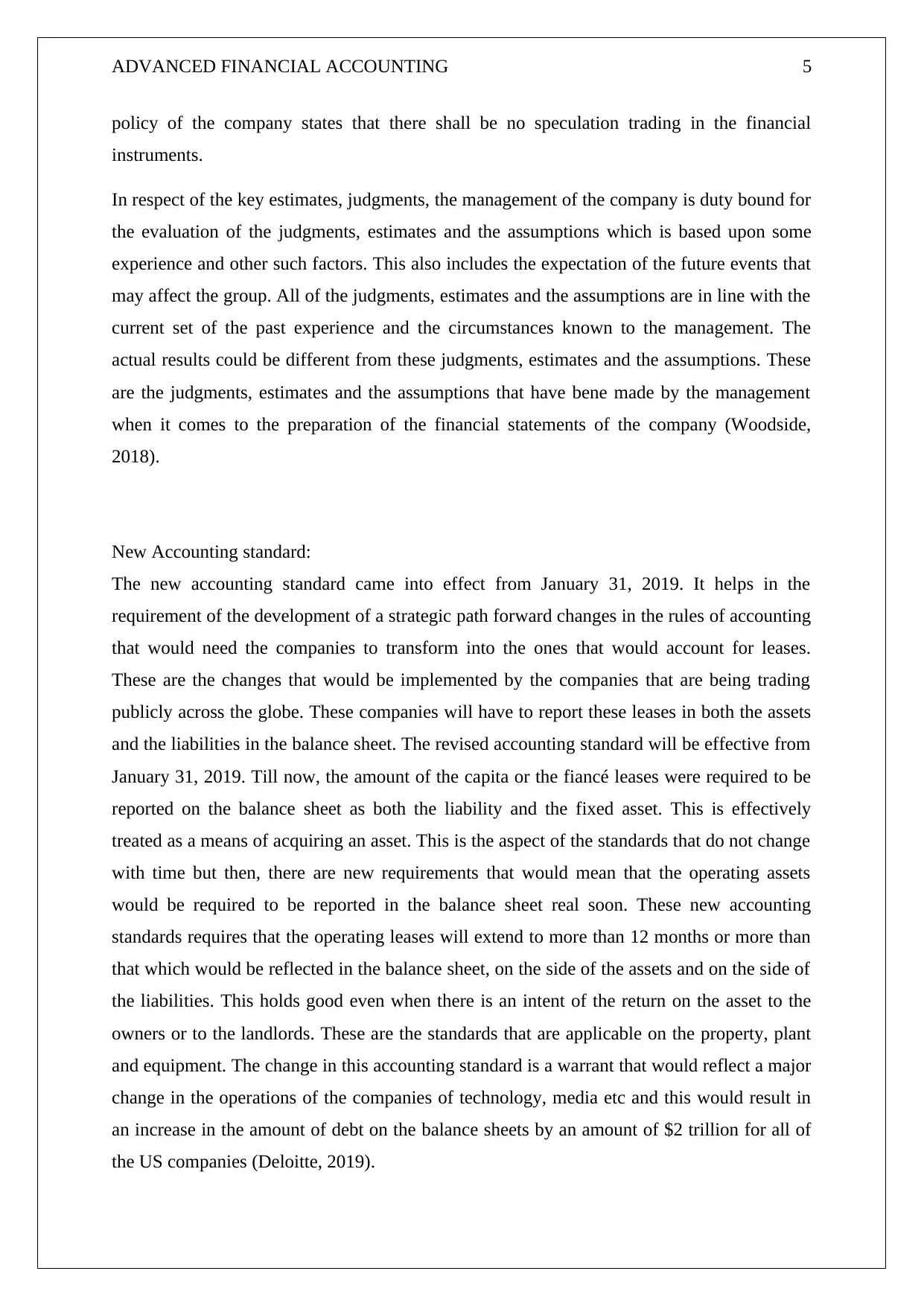
ADVANCED FINANCIAL ACCOUNTING 5
policy of the company states that there shall be no speculation trading in the financial
instruments.
In respect of the key estimates, judgments, the management of the company is duty bound for
the evaluation of the judgments, estimates and the assumptions which is based upon some
experience and other such factors. This also includes the expectation of the future events that
may affect the group. All of the judgments, estimates and the assumptions are in line with the
current set of the past experience and the circumstances known to the management. The
actual results could be different from these judgments, estimates and the assumptions. These
are the judgments, estimates and the assumptions that have bene made by the management
when it comes to the preparation of the financial statements of the company (Woodside,
2018).
New Accounting standard:
The new accounting standard came into effect from January 31, 2019. It helps in the
requirement of the development of a strategic path forward changes in the rules of accounting
that would need the companies to transform into the ones that would account for leases.
These are the changes that would be implemented by the companies that are being trading
publicly across the globe. These companies will have to report these leases in both the assets
and the liabilities in the balance sheet. The revised accounting standard will be effective from
January 31, 2019. Till now, the amount of the capita or the fiancé leases were required to be
reported on the balance sheet as both the liability and the fixed asset. This is effectively
treated as a means of acquiring an asset. This is the aspect of the standards that do not change
with time but then, there are new requirements that would mean that the operating assets
would be required to be reported in the balance sheet real soon. These new accounting
standards requires that the operating leases will extend to more than 12 months or more than
that which would be reflected in the balance sheet, on the side of the assets and on the side of
the liabilities. This holds good even when there is an intent of the return on the asset to the
owners or to the landlords. These are the standards that are applicable on the property, plant
and equipment. The change in this accounting standard is a warrant that would reflect a major
change in the operations of the companies of technology, media etc and this would result in
an increase in the amount of debt on the balance sheets by an amount of $2 trillion for all of
the US companies (Deloitte, 2019).
policy of the company states that there shall be no speculation trading in the financial
instruments.
In respect of the key estimates, judgments, the management of the company is duty bound for
the evaluation of the judgments, estimates and the assumptions which is based upon some
experience and other such factors. This also includes the expectation of the future events that
may affect the group. All of the judgments, estimates and the assumptions are in line with the
current set of the past experience and the circumstances known to the management. The
actual results could be different from these judgments, estimates and the assumptions. These
are the judgments, estimates and the assumptions that have bene made by the management
when it comes to the preparation of the financial statements of the company (Woodside,
2018).
New Accounting standard:
The new accounting standard came into effect from January 31, 2019. It helps in the
requirement of the development of a strategic path forward changes in the rules of accounting
that would need the companies to transform into the ones that would account for leases.
These are the changes that would be implemented by the companies that are being trading
publicly across the globe. These companies will have to report these leases in both the assets
and the liabilities in the balance sheet. The revised accounting standard will be effective from
January 31, 2019. Till now, the amount of the capita or the fiancé leases were required to be
reported on the balance sheet as both the liability and the fixed asset. This is effectively
treated as a means of acquiring an asset. This is the aspect of the standards that do not change
with time but then, there are new requirements that would mean that the operating assets
would be required to be reported in the balance sheet real soon. These new accounting
standards requires that the operating leases will extend to more than 12 months or more than
that which would be reflected in the balance sheet, on the side of the assets and on the side of
the liabilities. This holds good even when there is an intent of the return on the asset to the
owners or to the landlords. These are the standards that are applicable on the property, plant
and equipment. The change in this accounting standard is a warrant that would reflect a major
change in the operations of the companies of technology, media etc and this would result in
an increase in the amount of debt on the balance sheets by an amount of $2 trillion for all of
the US companies (Deloitte, 2019).
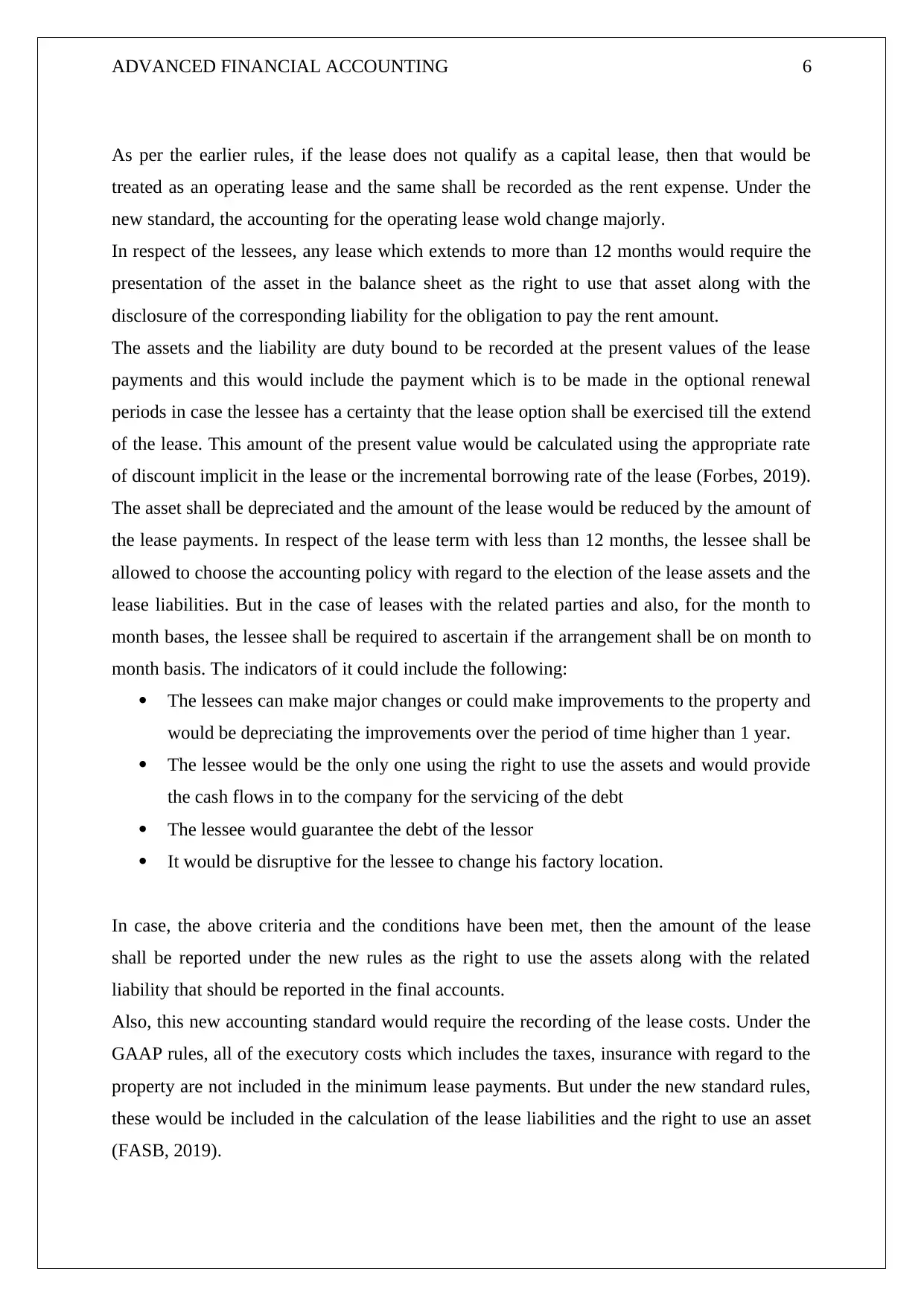
ADVANCED FINANCIAL ACCOUNTING 6
As per the earlier rules, if the lease does not qualify as a capital lease, then that would be
treated as an operating lease and the same shall be recorded as the rent expense. Under the
new standard, the accounting for the operating lease wold change majorly.
In respect of the lessees, any lease which extends to more than 12 months would require the
presentation of the asset in the balance sheet as the right to use that asset along with the
disclosure of the corresponding liability for the obligation to pay the rent amount.
The assets and the liability are duty bound to be recorded at the present values of the lease
payments and this would include the payment which is to be made in the optional renewal
periods in case the lessee has a certainty that the lease option shall be exercised till the extend
of the lease. This amount of the present value would be calculated using the appropriate rate
of discount implicit in the lease or the incremental borrowing rate of the lease (Forbes, 2019).
The asset shall be depreciated and the amount of the lease would be reduced by the amount of
the lease payments. In respect of the lease term with less than 12 months, the lessee shall be
allowed to choose the accounting policy with regard to the election of the lease assets and the
lease liabilities. But in the case of leases with the related parties and also, for the month to
month bases, the lessee shall be required to ascertain if the arrangement shall be on month to
month basis. The indicators of it could include the following:
The lessees can make major changes or could make improvements to the property and
would be depreciating the improvements over the period of time higher than 1 year.
The lessee would be the only one using the right to use the assets and would provide
the cash flows in to the company for the servicing of the debt
The lessee would guarantee the debt of the lessor
It would be disruptive for the lessee to change his factory location.
In case, the above criteria and the conditions have been met, then the amount of the lease
shall be reported under the new rules as the right to use the assets along with the related
liability that should be reported in the final accounts.
Also, this new accounting standard would require the recording of the lease costs. Under the
GAAP rules, all of the executory costs which includes the taxes, insurance with regard to the
property are not included in the minimum lease payments. But under the new standard rules,
these would be included in the calculation of the lease liabilities and the right to use an asset
(FASB, 2019).
As per the earlier rules, if the lease does not qualify as a capital lease, then that would be
treated as an operating lease and the same shall be recorded as the rent expense. Under the
new standard, the accounting for the operating lease wold change majorly.
In respect of the lessees, any lease which extends to more than 12 months would require the
presentation of the asset in the balance sheet as the right to use that asset along with the
disclosure of the corresponding liability for the obligation to pay the rent amount.
The assets and the liability are duty bound to be recorded at the present values of the lease
payments and this would include the payment which is to be made in the optional renewal
periods in case the lessee has a certainty that the lease option shall be exercised till the extend
of the lease. This amount of the present value would be calculated using the appropriate rate
of discount implicit in the lease or the incremental borrowing rate of the lease (Forbes, 2019).
The asset shall be depreciated and the amount of the lease would be reduced by the amount of
the lease payments. In respect of the lease term with less than 12 months, the lessee shall be
allowed to choose the accounting policy with regard to the election of the lease assets and the
lease liabilities. But in the case of leases with the related parties and also, for the month to
month bases, the lessee shall be required to ascertain if the arrangement shall be on month to
month basis. The indicators of it could include the following:
The lessees can make major changes or could make improvements to the property and
would be depreciating the improvements over the period of time higher than 1 year.
The lessee would be the only one using the right to use the assets and would provide
the cash flows in to the company for the servicing of the debt
The lessee would guarantee the debt of the lessor
It would be disruptive for the lessee to change his factory location.
In case, the above criteria and the conditions have been met, then the amount of the lease
shall be reported under the new rules as the right to use the assets along with the related
liability that should be reported in the final accounts.
Also, this new accounting standard would require the recording of the lease costs. Under the
GAAP rules, all of the executory costs which includes the taxes, insurance with regard to the
property are not included in the minimum lease payments. But under the new standard rules,
these would be included in the calculation of the lease liabilities and the right to use an asset
(FASB, 2019).
⊘ This is a preview!⊘
Do you want full access?
Subscribe today to unlock all pages.

Trusted by 1+ million students worldwide
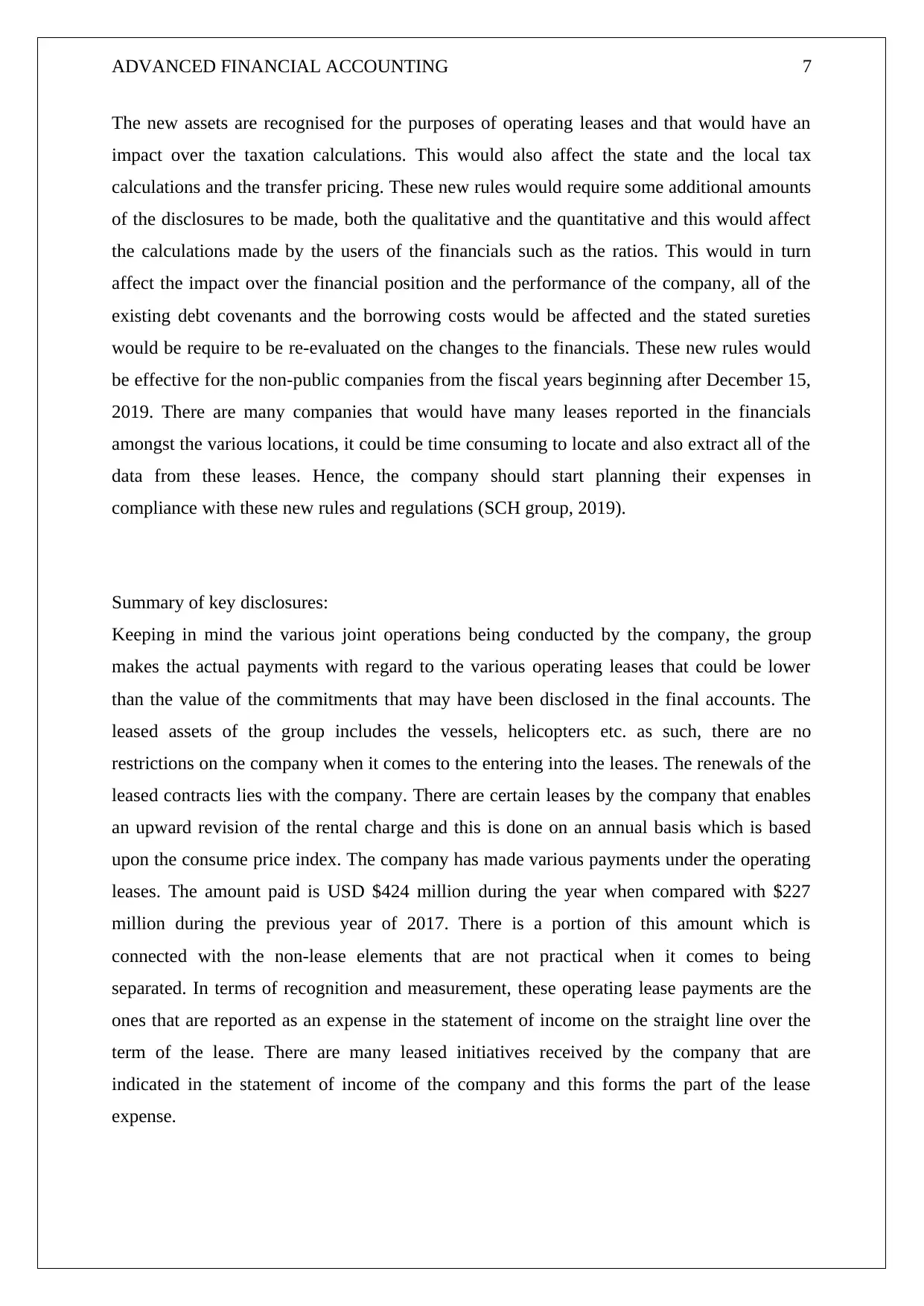
ADVANCED FINANCIAL ACCOUNTING 7
The new assets are recognised for the purposes of operating leases and that would have an
impact over the taxation calculations. This would also affect the state and the local tax
calculations and the transfer pricing. These new rules would require some additional amounts
of the disclosures to be made, both the qualitative and the quantitative and this would affect
the calculations made by the users of the financials such as the ratios. This would in turn
affect the impact over the financial position and the performance of the company, all of the
existing debt covenants and the borrowing costs would be affected and the stated sureties
would be require to be re-evaluated on the changes to the financials. These new rules would
be effective for the non-public companies from the fiscal years beginning after December 15,
2019. There are many companies that would have many leases reported in the financials
amongst the various locations, it could be time consuming to locate and also extract all of the
data from these leases. Hence, the company should start planning their expenses in
compliance with these new rules and regulations (SCH group, 2019).
Summary of key disclosures:
Keeping in mind the various joint operations being conducted by the company, the group
makes the actual payments with regard to the various operating leases that could be lower
than the value of the commitments that may have been disclosed in the final accounts. The
leased assets of the group includes the vessels, helicopters etc. as such, there are no
restrictions on the company when it comes to the entering into the leases. The renewals of the
leased contracts lies with the company. There are certain leases by the company that enables
an upward revision of the rental charge and this is done on an annual basis which is based
upon the consume price index. The company has made various payments under the operating
leases. The amount paid is USD $424 million during the year when compared with $227
million during the previous year of 2017. There is a portion of this amount which is
connected with the non-lease elements that are not practical when it comes to being
separated. In terms of recognition and measurement, these operating lease payments are the
ones that are reported as an expense in the statement of income on the straight line over the
term of the lease. There are many leased initiatives received by the company that are
indicated in the statement of income of the company and this forms the part of the lease
expense.
The new assets are recognised for the purposes of operating leases and that would have an
impact over the taxation calculations. This would also affect the state and the local tax
calculations and the transfer pricing. These new rules would require some additional amounts
of the disclosures to be made, both the qualitative and the quantitative and this would affect
the calculations made by the users of the financials such as the ratios. This would in turn
affect the impact over the financial position and the performance of the company, all of the
existing debt covenants and the borrowing costs would be affected and the stated sureties
would be require to be re-evaluated on the changes to the financials. These new rules would
be effective for the non-public companies from the fiscal years beginning after December 15,
2019. There are many companies that would have many leases reported in the financials
amongst the various locations, it could be time consuming to locate and also extract all of the
data from these leases. Hence, the company should start planning their expenses in
compliance with these new rules and regulations (SCH group, 2019).
Summary of key disclosures:
Keeping in mind the various joint operations being conducted by the company, the group
makes the actual payments with regard to the various operating leases that could be lower
than the value of the commitments that may have been disclosed in the final accounts. The
leased assets of the group includes the vessels, helicopters etc. as such, there are no
restrictions on the company when it comes to the entering into the leases. The renewals of the
leased contracts lies with the company. There are certain leases by the company that enables
an upward revision of the rental charge and this is done on an annual basis which is based
upon the consume price index. The company has made various payments under the operating
leases. The amount paid is USD $424 million during the year when compared with $227
million during the previous year of 2017. There is a portion of this amount which is
connected with the non-lease elements that are not practical when it comes to being
separated. In terms of recognition and measurement, these operating lease payments are the
ones that are reported as an expense in the statement of income on the straight line over the
term of the lease. There are many leased initiatives received by the company that are
indicated in the statement of income of the company and this forms the part of the lease
expense.
Paraphrase This Document
Need a fresh take? Get an instant paraphrase of this document with our AI Paraphraser
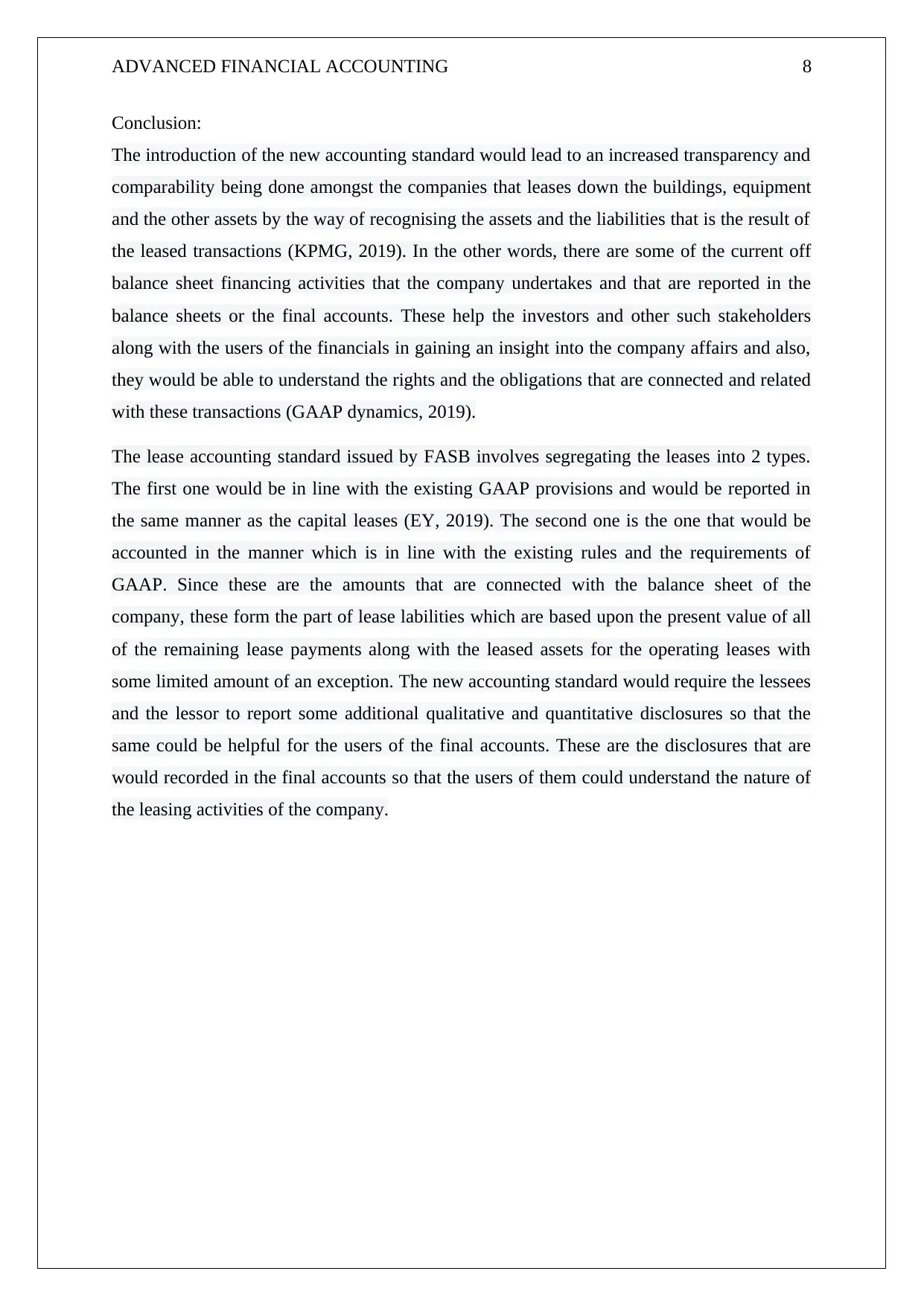
ADVANCED FINANCIAL ACCOUNTING 8
Conclusion:
The introduction of the new accounting standard would lead to an increased transparency and
comparability being done amongst the companies that leases down the buildings, equipment
and the other assets by the way of recognising the assets and the liabilities that is the result of
the leased transactions (KPMG, 2019). In the other words, there are some of the current off
balance sheet financing activities that the company undertakes and that are reported in the
balance sheets or the final accounts. These help the investors and other such stakeholders
along with the users of the financials in gaining an insight into the company affairs and also,
they would be able to understand the rights and the obligations that are connected and related
with these transactions (GAAP dynamics, 2019).
The lease accounting standard issued by FASB involves segregating the leases into 2 types.
The first one would be in line with the existing GAAP provisions and would be reported in
the same manner as the capital leases (EY, 2019). The second one is the one that would be
accounted in the manner which is in line with the existing rules and the requirements of
GAAP. Since these are the amounts that are connected with the balance sheet of the
company, these form the part of lease labilities which are based upon the present value of all
of the remaining lease payments along with the leased assets for the operating leases with
some limited amount of an exception. The new accounting standard would require the lessees
and the lessor to report some additional qualitative and quantitative disclosures so that the
same could be helpful for the users of the final accounts. These are the disclosures that are
would recorded in the final accounts so that the users of them could understand the nature of
the leasing activities of the company.
Conclusion:
The introduction of the new accounting standard would lead to an increased transparency and
comparability being done amongst the companies that leases down the buildings, equipment
and the other assets by the way of recognising the assets and the liabilities that is the result of
the leased transactions (KPMG, 2019). In the other words, there are some of the current off
balance sheet financing activities that the company undertakes and that are reported in the
balance sheets or the final accounts. These help the investors and other such stakeholders
along with the users of the financials in gaining an insight into the company affairs and also,
they would be able to understand the rights and the obligations that are connected and related
with these transactions (GAAP dynamics, 2019).
The lease accounting standard issued by FASB involves segregating the leases into 2 types.
The first one would be in line with the existing GAAP provisions and would be reported in
the same manner as the capital leases (EY, 2019). The second one is the one that would be
accounted in the manner which is in line with the existing rules and the requirements of
GAAP. Since these are the amounts that are connected with the balance sheet of the
company, these form the part of lease labilities which are based upon the present value of all
of the remaining lease payments along with the leased assets for the operating leases with
some limited amount of an exception. The new accounting standard would require the lessees
and the lessor to report some additional qualitative and quantitative disclosures so that the
same could be helpful for the users of the final accounts. These are the disclosures that are
would recorded in the final accounts so that the users of them could understand the nature of
the leasing activities of the company.
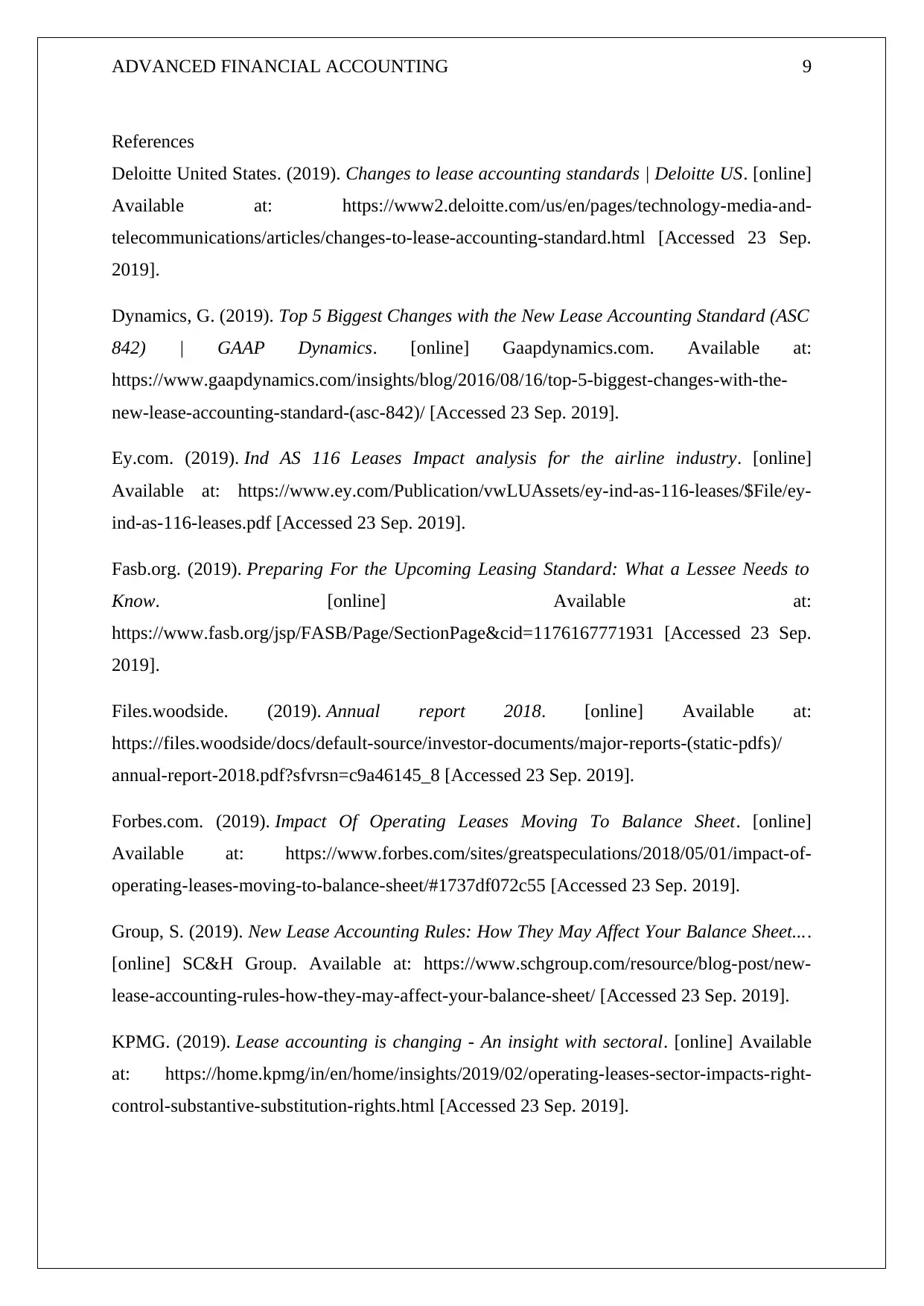
ADVANCED FINANCIAL ACCOUNTING 9
References
Deloitte United States. (2019). Changes to lease accounting standards | Deloitte US. [online]
Available at: https://www2.deloitte.com/us/en/pages/technology-media-and-
telecommunications/articles/changes-to-lease-accounting-standard.html [Accessed 23 Sep.
2019].
Dynamics, G. (2019). Top 5 Biggest Changes with the New Lease Accounting Standard (ASC
842) | GAAP Dynamics. [online] Gaapdynamics.com. Available at:
https://www.gaapdynamics.com/insights/blog/2016/08/16/top-5-biggest-changes-with-the-
new-lease-accounting-standard-(asc-842)/ [Accessed 23 Sep. 2019].
Ey.com. (2019). Ind AS 116 Leases Impact analysis for the airline industry. [online]
Available at: https://www.ey.com/Publication/vwLUAssets/ey-ind-as-116-leases/$File/ey-
ind-as-116-leases.pdf [Accessed 23 Sep. 2019].
Fasb.org. (2019). Preparing For the Upcoming Leasing Standard: What a Lessee Needs to
Know. [online] Available at:
https://www.fasb.org/jsp/FASB/Page/SectionPage&cid=1176167771931 [Accessed 23 Sep.
2019].
Files.woodside. (2019). Annual report 2018. [online] Available at:
https://files.woodside/docs/default-source/investor-documents/major-reports-(static-pdfs)/
annual-report-2018.pdf?sfvrsn=c9a46145_8 [Accessed 23 Sep. 2019].
Forbes.com. (2019). Impact Of Operating Leases Moving To Balance Sheet. [online]
Available at: https://www.forbes.com/sites/greatspeculations/2018/05/01/impact-of-
operating-leases-moving-to-balance-sheet/#1737df072c55 [Accessed 23 Sep. 2019].
Group, S. (2019). New Lease Accounting Rules: How They May Affect Your Balance Sheet....
[online] SC&H Group. Available at: https://www.schgroup.com/resource/blog-post/new-
lease-accounting-rules-how-they-may-affect-your-balance-sheet/ [Accessed 23 Sep. 2019].
KPMG. (2019). Lease accounting is changing - An insight with sectoral. [online] Available
at: https://home.kpmg/in/en/home/insights/2019/02/operating-leases-sector-impacts-right-
control-substantive-substitution-rights.html [Accessed 23 Sep. 2019].
References
Deloitte United States. (2019). Changes to lease accounting standards | Deloitte US. [online]
Available at: https://www2.deloitte.com/us/en/pages/technology-media-and-
telecommunications/articles/changes-to-lease-accounting-standard.html [Accessed 23 Sep.
2019].
Dynamics, G. (2019). Top 5 Biggest Changes with the New Lease Accounting Standard (ASC
842) | GAAP Dynamics. [online] Gaapdynamics.com. Available at:
https://www.gaapdynamics.com/insights/blog/2016/08/16/top-5-biggest-changes-with-the-
new-lease-accounting-standard-(asc-842)/ [Accessed 23 Sep. 2019].
Ey.com. (2019). Ind AS 116 Leases Impact analysis for the airline industry. [online]
Available at: https://www.ey.com/Publication/vwLUAssets/ey-ind-as-116-leases/$File/ey-
ind-as-116-leases.pdf [Accessed 23 Sep. 2019].
Fasb.org. (2019). Preparing For the Upcoming Leasing Standard: What a Lessee Needs to
Know. [online] Available at:
https://www.fasb.org/jsp/FASB/Page/SectionPage&cid=1176167771931 [Accessed 23 Sep.
2019].
Files.woodside. (2019). Annual report 2018. [online] Available at:
https://files.woodside/docs/default-source/investor-documents/major-reports-(static-pdfs)/
annual-report-2018.pdf?sfvrsn=c9a46145_8 [Accessed 23 Sep. 2019].
Forbes.com. (2019). Impact Of Operating Leases Moving To Balance Sheet. [online]
Available at: https://www.forbes.com/sites/greatspeculations/2018/05/01/impact-of-
operating-leases-moving-to-balance-sheet/#1737df072c55 [Accessed 23 Sep. 2019].
Group, S. (2019). New Lease Accounting Rules: How They May Affect Your Balance Sheet....
[online] SC&H Group. Available at: https://www.schgroup.com/resource/blog-post/new-
lease-accounting-rules-how-they-may-affect-your-balance-sheet/ [Accessed 23 Sep. 2019].
KPMG. (2019). Lease accounting is changing - An insight with sectoral. [online] Available
at: https://home.kpmg/in/en/home/insights/2019/02/operating-leases-sector-impacts-right-
control-substantive-substitution-rights.html [Accessed 23 Sep. 2019].
⊘ This is a preview!⊘
Do you want full access?
Subscribe today to unlock all pages.

Trusted by 1+ million students worldwide
1 out of 9
Related Documents
Your All-in-One AI-Powered Toolkit for Academic Success.
+13062052269
info@desklib.com
Available 24*7 on WhatsApp / Email
![[object Object]](/_next/static/media/star-bottom.7253800d.svg)
Unlock your academic potential
Copyright © 2020–2025 A2Z Services. All Rights Reserved. Developed and managed by ZUCOL.





